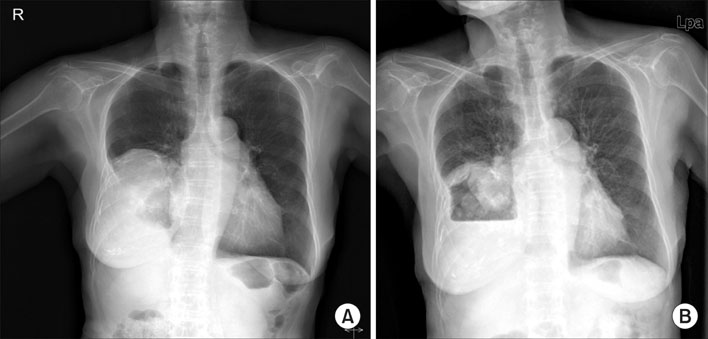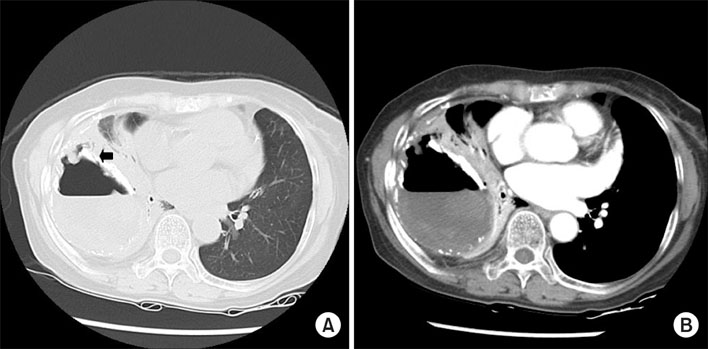Tuberc Respir Dis.
2008 Jan;64(1):48-51. 10.4046/trd.2008.64.1.48.
A Case of Chronic Expanding Hematoma with Initial Presentation as Massive Hemotpysis through Bronchopleural Fistula in the Thorax
- Affiliations
-
- 1Department of Internal Medicine, The Catholic University of Korea College of Medicine, Seoul, Korea. youngkim@catholic.ac.kr
- 2Department of Radiology, The Catholic University of Korea College of Medicine, Seoul, Korea.
- KMID: 1478142
- DOI: http://doi.org/10.4046/trd.2008.64.1.48
Abstract
- Chronic expanding hematoma of the thorax is a specific subtype of the chronic empyema. It presents as a slowly expanding intrathoracic mass which result in dyspnea or recurrent hemoptysis. The symptoms develop months or years after tuberculous pleurisy, trauma or surgery. Usually, it shows three common findings: a giant mass lesion in the thorax, some surrounding calcifications, the absence of signs or symptoms of infection. We report a case of chronic expanding hematoma of the thorax, initially presenting as massive hemoptysis through bronchopleural fistula which resulted in radiologic findings of new air-fluid level within the previous pleural lesion filled with unknown materials.
Figure
Reference
-
1. Reid JD, Kommareddi S, Lankerani M, Park MC. Chronic expanding hematomas. A clinicopathologic entity. JAMA. 1980. 244:2441–2442.2. Kwon YS, Koh WJ, Kim TS, Lee KS, Kim BT, Shim YM. Chronic expanding hematoma of the thorax. Yonsei Med J. 2007. 48:337–340.3. Sato M, Kosaka S, Takahashi T. Life threatening chronic expanding hematoma of the thorax. J Cardiovasc Surg (Torino). 2004. 45:511–514.4. Okubo K, Okamoto T, Isobe J, Ueno Y. Rupture of a chronic expanding hematoma of the thorax into lung parenchyma. J Thorac Cardiovasc Surg. 2004. 127:1838–1840.5. Hanagiri T, Muranaka H, Hashimoto M, Nishio T, Sakai S, Ono M, et al. Chronic expanding hematoma in the chest. Ann Thorac Surg. 1997. 64:559–561.6. Hwang GL, Moffatt SD, Mitchell JD, Leung AN. Chronic expanding hematoma of the thorax. AJR Am J Roentgenol. 2003. 180:1182–1183.7. Athanassiadi K, Reiffen HP, Dickgreber N, Laenger F, Eschenbruch CM, Wilchelmi M, et al. A different surgical approach for an intrathoracic expanding hematoma. J Thorac Cardiovasc Surg. 2007. 133:832–834.8. Labadie EL, Glover D. Physiopathogenesis of subdural hematomas. Part 1: Histological and biochemical comparisons of subcutaneous hematoma in rats with subdural hematoma in man. J Neurosurg. 1976. 45:382–392.
- Full Text Links
- Actions
-
Cited
- CITED
-
- Close
- Share
- Similar articles
-
- A Case of Spontaneous Chronic Expanding Hematoma in the Thorax
- Use of the Free Flap for Large Defect with Bronchopleural Fistula: Case Report
- Various Bronchial Fistulas: Pitfalls and Usefulness on CT. A Pictorial Review
- Peripheral Bronchopleural Fistula: CT Evaluation in 22 patients
- A Case of Bronchoscopic Treatment of a Bronchopleural Fistula Accompanied by Pneumonia




